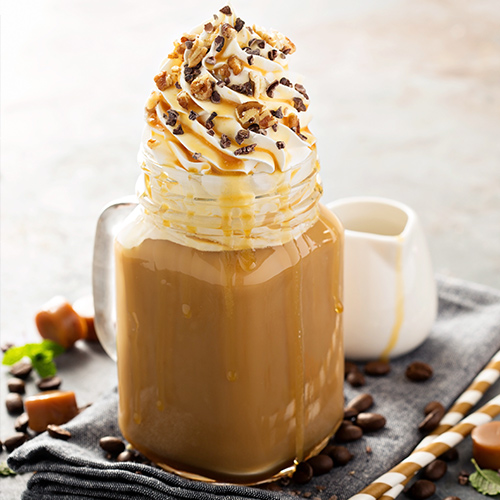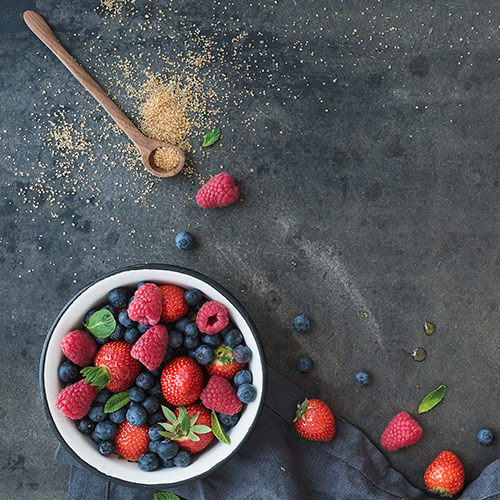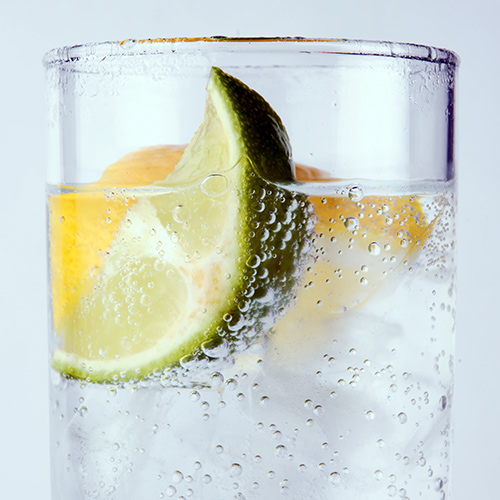
Resolution:
Drink Less Sugar
Author: be well™ with Big Y® Registered Dietitian Team
There’s nothing like getting your morning started with a cup of coffee, sipping on hot chocolate throughout a wintry morning or pepping up a mid-day energy slump with a latte. And who can resist a refreshing glass of bubbly soda with lunch or frozen icee margarita at dinner? When you get in the habit of drinking a number of added sugar-sweetened beverages like these throughout the day, your health and waistline will take a hit.
Sweet drinks little secret.

The amount of added sugar you consume each day can add up rather quickly if you’re not paying attention. Drinking added sugars through the beverages you choose is one of the easiest, mindless ways to add excess calories to your daily meal plan. Without barely noticing, you can drink 22 grams and about 90 additional calories from added sugars in a 16-ounce cinnamon-flavored latte.
Overtime, drinking an excessive amount of added sugars (and thereby excess calories) can lead to weight gain. The progression will be slow. Over the course of a season, you may notice your clothes feeling a bit tighter without knowing why. All the while, the answer is right in your cup.
Not all sugars are created equal.

There are differences in the types of sugars we consume. For example, fruit provides naturally-occurring sugar we call intrinsic sugar. Intrinsic sugars are not the sugars of concern when it comes to maintaining your health and waistline. Added sugars are those used while cooking and/or added to food and beverages before you eat them. Added sugars are a concern because they rarely provide any additional nutrition other than calories. You can learn more in our A Sugar By Another Name article.
How much sugar is too much?

The American Heart Association® recommends no more than 150 calories (or 36 grams) added sugar each day for men and 100 calories (or 25 grams) for women.
The 2020-2025 Dietary Guidelines for Americans recommend no more than 10% Total Calories come from added sugars for everyone over the age of 2. This guide translates to about 200 calories (or 48 grams or 12 teaspoons) for an individual following a 2,000-calorie meal plan.
Since added sugars come from a variety of food sources, from desserts and sweets to yogurts, sauces and cereals, your total intake from one day to the next is impacted by what you drink and the foods you eat.
Added sugars add up throughout the day.

Sipping on a large cinnamon latte every day may not seem like an issue when keeping tabs on your added sugar intake, but look what happens when you add in additional added sugars from the food:
- 14 grams from cereal at breakfast
- 4 grams from pasta sauce at lunch
- 8 grams from raspberry vinaigrette at lunch
- 17 grams from dessert at dinner
This adds up to a total of 65 grams and 260 calories just from added sugar. As you see, it’s very easy to surpass the added sugar recommendations from the American Heart Association® and Dietary Guidelines for Americans if you are not mindful of your food and drink choices.
Strategies for drinking less sugar from our registered dietitians.

Tip #1: Use still water, sparkling water, herbal tea, tea and coffee without any sugar added as your primary way to stay hydrated throughout the day.
Tip #2: If your coffee or tea just won’t do without sweetener, consider drinking less throughout the day; minimizing the amount of sugar you use slowly, over time, so your taste buds become accustomed to less sweetness; or opting for a small amount of a non-nutritive sweetener like monk fruit or stevia in place of traditional sugar.
Beware: Non-nutritive sweeteners tend to provide a more intense sweet flavor than traditional sugar. Keep tabs on the amount used so your taste buds don’t come to expect higher levels of sweet flavoring from your foods and beverages.
Tip #3: Handle added sugar-sweetened beverages as treats like any other dessert. These beverages are not off limits, simply indulge in them every now and then as you would with sweets and baked goods.
Published 1/9/2023


